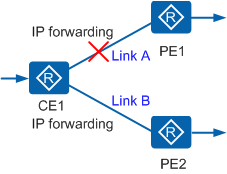IP FRR
Definition
IP fast reroute (FRR) is a method that implements fast route backup. It enables a router to immediately use a backup link for packet forwarding if the router detects a fault at the physical or data link layer. With IP FRR, the router also reports the fault to the upper-layer routing system.
Purpose
On traditional IP networks, when a fault occurs at the lower layer on a network, the physical interface on the router becomes Down. After the router detects the fault, it informs the upper-layer routing system to recalculate routes and then updates routing information. Usually, it takes the routing system several seconds to re-select an available route.
Second-level convergence is intolerable to services that are sensitive to delay and packet loss because it may lead to service interruptions. For example, Voice over Internet Protocol (VoIP) services are only tolerant of millisecond-level interruptions.
IP FRR resolves this by ensuring that the forwarding system rapidly detects a link fault and then uses a backup route to restore services as soon as possible.
IP FRR Classification and Implementation
IP FRR, which is designed for routes on IP networks, is classified into IP FRR on public networks and IP FRR on private networks.
Public network IP FRR protects routers on public networks.
Private network IP FRR protects Customer Edges (CEs).
IP FRR is implemented as follows:
If the primary link is available, you can configure an IP FRR policy to provide the forwarding information of the backup route to the forwarding engine.
If the forwarding engine detects a primary link fault, the engine uses the backup link to forward traffic before the routes on the control plane converge.
Comparison Between IP FRR and VPN FRR
Item |
Description |
|---|---|
IP FRR |
IP FRR is suitable for IP services that require a low delay and low packet loss ratio.
|
VPN FRR |
VPN FRR is suitable for services that require a low delay and low packet loss ratio on VPNs.
|
Comparison Between IP FRR and Load Balancing
Item |
Description |
|---|---|
IP FRR |
Implements FRR through a backed up route. IP FRR is applicable to networks where a master link and a backup link exist and load balancing is not configured. |
Load Balancing |
Implements fast route switching through equal-cost routes. Load balancing is applicable to multi-link networking with load balancing. |
IP FRR Typical Application
In the example shown in Figure 1, IP FRR is configured to improve network reliability. CE1 is dual-homed to PE1 and PE2 and has two outbound interfaces and two next hops configured. That is, link B functions as the backup of link A. When link A fails, traffic can be rapidly switched to link B.
